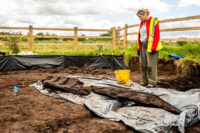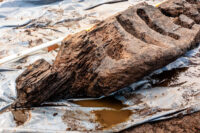 A rare carved wooden idol made more than 1600 years ago was discovered in a bog in Gortnacrannagh, Co Roscommon, western Ireland. The artifact was made from a split oak trunk and carved into a vaguely anthropomorphic shape, with a small round head at the top, small shoulders and a long body carved with deep horizontal notches. It is one of only twelve Iron Age idols of its kind found in Ireland, and is the largest of them at more than eight feet long.
A rare carved wooden idol made more than 1600 years ago was discovered in a bog in Gortnacrannagh, Co Roscommon, western Ireland. The artifact was made from a split oak trunk and carved into a vaguely anthropomorphic shape, with a small round head at the top, small shoulders and a long body carved with deep horizontal notches. It is one of only twelve Iron Age idols of its kind found in Ireland, and is the largest of them at more than eight feet long.
Wooden idols are known from bogs across northern Europe where waterlogged conditions allow for the preservation of ancient wood.
“The lower ends of several figures were also worked to a point suggesting that they may once have stood upright,” said wood specialist, Cathy Moore.
“Their meaning is open to interpretation, but they may have marked special places in the landscape, have represented particular individuals or deities or perhaps have functioned as wooden bog bodies, sacrificed in lieu of humans.”
Archaeologists believe this idol too was likely originally planted in the ground where it was the center point of some ceremony or ritual. It was found face-down and broken in two parts, so they don’t believe it fell where it stood, but rather was decommissioned, taken down and laid to rest. It may even have become an object of sacrifice itself. Along with the idol, the team also found Iron Age ploughs, daggers, spears, Bronze Age gold pins and large quantities of animal bones and even some human bones. All of these are evidence that the Iron Age residents of the area used the bog for votive deposits and for animal sacrifice.
 Radiocarbon analysis dates the idol to between 200 and 400 A.D., which is actually on the later side for this type of artifact. The outside date is only a century before St. Patrick evangelized Ireland, so it’s an important survival of pre-Christian religious practices on the island.
Radiocarbon analysis dates the idol to between 200 and 400 A.D., which is actually on the later side for this type of artifact. The outside date is only a century before St. Patrick evangelized Ireland, so it’s an important survival of pre-Christian religious practices on the island.
It takes on added significance because it was excavated by professional archaeologists in its original context. The other 11 idols were found by accident, often by peat cutters, so only the orphaned objects themselves survive. This one was surrounded by artifacts and remains attesting to the religious ceremonies associated with the idol.
The idol is now undergoing conservation at University College Dublin. It is in a bath of polyethylene glycol (PEG), a polymer that replaces the water in wood ensuring it doesn’t warp or shrink when it dries. The idol will have to remain in this bath for three years before the wood is stable enough to be exposed to air. When it’s ready, it will go on display at the National Museum of Ireland. Meanwhile, a replica is being made of oak posts for display in the Rathcroghan Centre in Tulsk, Co Roscommon, near when the artifact was found.
“Besides, they believe that due to celestial magnitude their gods must not be retained within walls nor modeled in any form after the human shape: They consecrate glades and groves and call by the names of their gods that secret that they watch in sole reverence” – (Tacitus)
i.e. maybe, almost like Cathy Moore 😉
—-
“Ceterum nec cohibere parietibus deos neque in ullam humani oris speciem adsimulare ex magnitudine caelestium arbitrantur: lucos ac nemora consecrant deorumque nominibus appellant secretum illud, quod sola reverentia vident.”
—-
Looks like it may have been a ladder at a dock.